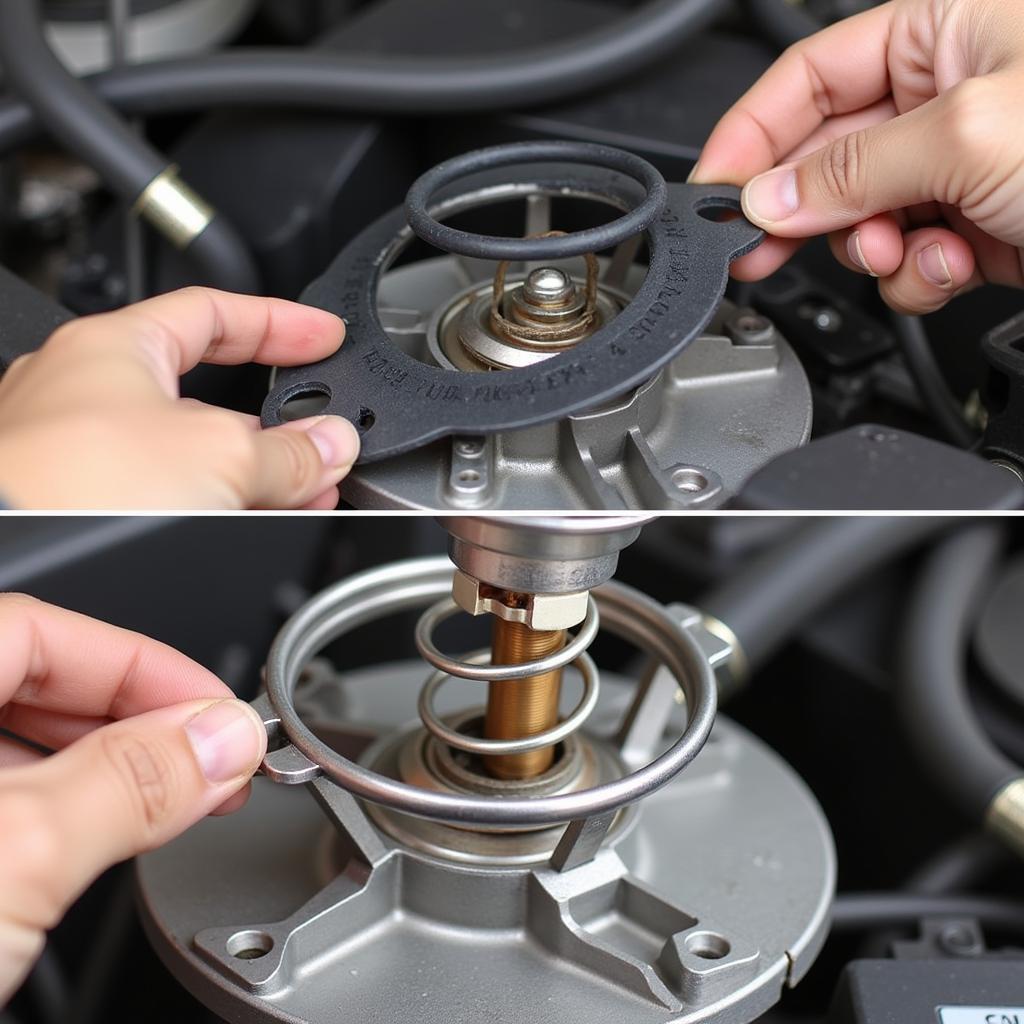Replacing a car thermostat is a relatively straightforward job that many DIYers can tackle. Knowing the right Tools Needed To Replace Car Thermostat will make the process smoother and prevent potential headaches. This article will guide you through the essential tools required for this task, providing valuable insights and expert tips for a successful thermostat replacement.
Having the correct tools will not only make the job easier but also help you avoid damaging other components in your engine bay. Let’s delve into the essential tools you’ll need.
Before we start, having a clean and organized workspace is crucial. This helps you keep track of parts and tools, preventing loss or misplacement. A well-lit area is also essential for better visibility. Remember safety first! Allow your engine to cool down completely before you begin.
The most basic tools you’ll need include a socket set, screwdrivers, pliers, and a ratchet wrench. These will help you access and remove the bolts holding the thermostat housing in place. A drain pan is crucial for collecting the coolant that will spill out when you detach the hoses.
Beyond these basics, specialized tools can significantly improve the efficiency and accuracy of the job. A torque wrench is essential for tightening the bolts to the correct specification, preventing over-tightening, which can damage the housing or under-tightening, leading to leaks.
Having a new thermostat gasket is essential for ensuring a proper seal and preventing coolant leaks after reassembly. Don’t reuse the old one! Also, having a container of fresh coolant ready ensures you can refill the system correctly after replacing the thermostat.
If you’re working on a particularly tight engine bay, flexible hose clamp pliers can be incredibly helpful for reaching and removing those tricky hose clamps. These pliers provide a secure grip and allow you to work in confined spaces with greater ease.
Why Do I Need Specific Tools to Replace a Thermostat?
Using the correct tools is paramount for a successful thermostat replacement. Improvised tools or incorrect sizes can damage components, leading to costly repairs. Using a car town tool may not be the best solution in this instance. The correct tools ensure proper fit and function, leading to a leak-free and efficient cooling system.
For example, using the wrong size socket can strip the bolt heads, making removal incredibly difficult. Similarly, using regular pliers instead of hose clamp pliers can damage the clamps and hoses, leading to potential leaks.
What are the Steps Involved in Replacing a Car Thermostat?
The process generally involves draining the coolant, removing the thermostat housing, replacing the thermostat and gasket, reassembling the housing, and refilling the coolant.
Draining the Coolant
Locate the drain petcock on your radiator and carefully open it, allowing the coolant to drain into your drain pan.
Removing the Thermostat Housing
Once the coolant is drained, locate the thermostat housing and carefully remove the bolts using the appropriate socket and ratchet wrench. Gently detach the hoses connected to the housing.
Replacing the Thermostat and Gasket
Remove the old thermostat and gasket. Clean the mating surfaces of the housing and install the new thermostat and gasket.
 Installing the New Car Thermostat and Gasket
Installing the New Car Thermostat and Gasket
Reassembling and Refilling
Reinstall the thermostat housing and tighten the bolts to the manufacturer’s specified torque using a torque wrench. Reconnect the hoses and refill the cooling system with fresh coolant.
“Using a torque wrench is crucial,” says John Miller, a seasoned automotive technician with over 20 years of experience. “Over-tightening can crack the housing, while under-tightening can cause leaks. A torque wrench ensures the correct pressure is applied, preventing these issues.”
What if I Don’t Have All the Tools?
If you lack certain specialized tools, such as a torque wrench or flexible hose clamp pliers, consider borrowing them from a friend, renting them from a tool rental store, or having a professional mechanic perform the replacement.
Importance of the Right Tools
Using the correct tools ensures a safe and efficient repair, minimizing the risk of damage and ensuring the longevity of your vehicle’s cooling system. For specific car models, like a 1998 Lincoln Town Car, you may need particular tools, so researching the tools needed to change thermostat on 98 lincoln town car is advisable.
Conclusion
Knowing the tools needed to replace car thermostat empowers you to perform this task efficiently and effectively. By investing in the right tools and following the correct procedures, you can ensure a smooth and successful thermostat replacement, keeping your car’s cooling system in optimal condition. Don’t forget the importance of preventative maintenance, like regular car engine diagnostic ford focus, to catch potential issues early on.
FAQs
-
How often should I replace my car thermostat? Generally, every 3-4 years or as recommended by your vehicle’s manufacturer.
-
What are the signs of a failing thermostat? Overheating, fluctuating engine temperature, poor heater performance.
-
Can I reuse the old thermostat gasket? No, always replace the gasket with a new one to ensure a proper seal.
-
What type of coolant should I use? Consult your vehicle’s owner’s manual for the recommended coolant type.
-
How long does it take to replace a thermostat? Typically, 1-2 hours, depending on your vehicle’s make and model.
-
What happens if I don’t replace a bad thermostat? It can lead to engine overheating and potentially serious engine damage.
-
Is it difficult to replace a car thermostat? It’s a relatively straightforward job for DIYers with basic mechanical skills.
Need help with your car diagnostic? Contact us via WhatsApp: +1(641)206-8880, Email: [email protected] or visit us at 910 Cedar Lane, Chicago, IL 60605, USA. Our customer service team is available 24/7.

Leave a Reply